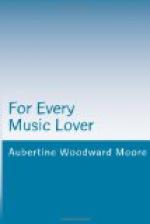That adventurous spirit, Claudio Monteverde, who nearly three hundred years ago made himself responsible for the first feeble utterances of an orchestra that tried to say something for itself, divined the possibilities of expression in varying combinations of tone-quality and gave vigorous impulse to the germ of the symphony already existing in the formless instrumental preludes and interludes of his predecessors among opera-makers. His revelation of the charm that lies in exploring the resources of instrumentation led to ever increasing demands on the orchestra. The prelude developed into the operatic overture whose business it became to prepare the spectator for what followed. That music was capable of conveying an impression in her own tone-language was apparent, and in due time the symphony rose majestic from the forge of genius.
Prominent among the materials welded into it was the dance of obscure origin. As the vocal aria was the result of the simple folk-song combined with the intense craving of song’s master molders for individual expression, so instrumental music striving to walk alone, without support from words, gained vital elements through the discovery that various phases of mental disposition might be indicated by alternating dance tunes differing in rhythm and movement, according to Nature’s own law of contrasts. That unity of purpose was essential to the effectiveness of the diversity was instinctively discerned.
The touch of authority was given to this kind of music, during the last two decades of the seventeenth century, by Arcangelo Corelli when he presented in the camera, or private apartment, of Cardinal Ottoboni’s palace, in Rome, his idealized dance groups, thoroughly united by harmony of mood, yet affording a wholly new tone-picture of this mood in each of several movements. These compositions were usually written for the harpsichord and perhaps three instruments of the viol order, the master himself playing the leading melody on the violin. He called them sonatas from sonare, to sound, a name originally applied to any piece that was sounded by instruments, not sung by the human voice. They prefigured the solo sonata, the entire class of chamber music named from the place where they were performed, and the symphony which is a sonata for the orchestra. Absolute music was set once for all on the right path by them. They ushered in a new era of Art.
Purcell, in England, Domenico Scarlatti and Sammartini, in Italy, the Bachs, in Germany, and others continued to fashion the sonata form. It ceased to be a mere grouping of dances, the name suite being applied to that, and struck out into independent excursions in the domain of fancy. The prevailing melody of its monophonic style proved suitable to furnish a subject for the most animated discussion. Three contrasting movements were adopted, comprising a summons to attention, an appeal to both intellect and emotions, and a lively reaction after excitement.




